美国纽约州律师资格考试复习笔记 宪法
- 格式:doc
- 大小:226.07 KB
- 文档页数:20
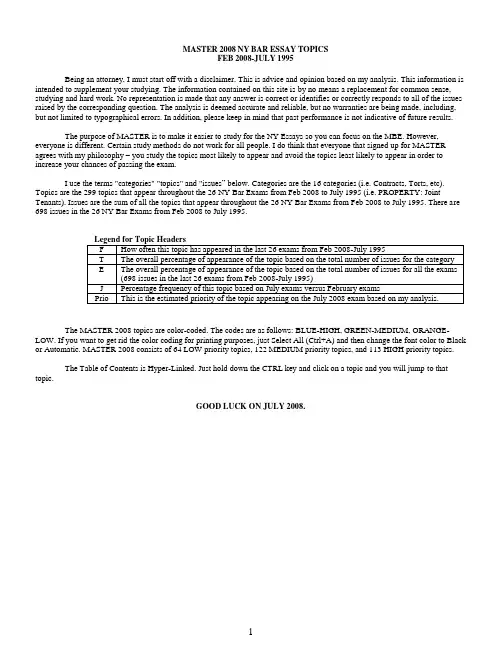
MASTER2008NY BAR ESSAY TOPICSFEB2008-JULY1995Being an attorney, I must start off with a disclaimer. This is advice and opinion based on my analysis. This information is intended to supplement your studying. The information contained on this site is by no means a replacement for common sense, studying and hard work. No representation is made that any answer is correct or identifies or correctly responds to all of the issues raised by the corresponding question. The analysis is deemed accurate and reliable, but no warranties are being made, including, but not limited to typographical errors. In addition, please keep in mind that past performance is not indicative of future results.The purpose of MASTER is to make it easier to study for the NY Essays so you can focus on the MBE. However, everyone is different. Certain study methods do not work for all people. I do think that everyone that signed up for MASTER agrees with my philosophy – you study the topics most likely to appear and avoid the topics least likely to appear in order to increase your chances of passing the exam.I use the terms "categories" "topics" and "issues” below. Categories are the 16 categories (i.e. Contracts, Torts, etc). Topics are the 299 topics that appear throughout the 26 NY Bar Exams from Feb 2008 to July 1995 (i.e. PROPERTY: Joint Tenants). Issues are the sum of all the topics that appear throughout the 26 NY Bar Exams from Feb 2008 to July 1995. There are 698 issues in the 26 NY Bar Exams from Feb 2008 to July 1995.The MASTER 2008 topics are color-coded. The codes are as follows: BLUE-HIGH, GREEN-MEDIUM, ORANGE-LOW. If you want to get rid the color coding for printing purposes, just Select All (Ctrl+A) and then change the font color to Black or Automatic. MASTER 2008 consists of 64 LOW priority topics, 122 MEDIUM priority topics, and 113 HIGH priority topics.The Table of Contents is Hyper-Linked. Just hold down the CTRL key and click on a topic and you will jump to that topic.GOOD LUCK ON JULY 2008.TABLE OF CONTENTSAGENCY/PARTNERSHIP–8 OF 26EXAMS- OVERALL ISSUE FREQUENCY 1.3% (8)AGENT-PART: Agent - F:2 - T:22.22% - E:0.29% - J:50.00% - Prio: LOW (8)AGENT-PART: Limited Partnership - F:1 - T:11.11% - E:0.14% - J:100.00% - Prio: LOW (8)AGENT-PART: Partnerships - F:6 - T:66.67% - E:0.86% - J:83.33% - Prio: LOW (8)CONFLICT OF LAWS–8 OF 26EXAMS- OVERALL ISSUE FREQUENCY 1.1% (8)CONFLICT: Conflict of Law - F:8 - T:100.00% - E:1.15% - J:50.00% - Prio: MED (8)CONSTITUTIONAL LAW–3 OF 26EXAMS- OVERALL ISSUE FREQUENCY 0.4% (9)CONLAW: Freedom of Speech - F:1 - T:33.33% - E:0.14% - J:0.00% - Prio: LOW (9)CONLAW: Takings - F:2 - T:66.67% - E:0.29% - J:50.00% - Prio: LOW (9)CONTRACTS–26 OF 26EXAMS- OVERALL ISSUE FREQUENCY 11.9% (9)CONTRACT: Accord and Satisfaction - F:1 - T:1.20% - E:0.14% - J:100.00% - Prio: LOW (9)CONTRACT: Anticipatory Repudiation - F:2 - T:2.41% - E:0.29% - J:100.00% - Prio: HIGH (9)CONTRACT: Battle of Forms/Mirror Image Rule - F:3 - T:3.61% - E:0.43% - J:33.33% - Prio: HIGH (10)CONTRACT: Breach by Buyer - F:2 - T:2.41% - E:0.29% - J:100.00% - Prio: HIGH (10)CONTRACT: Breach by Seller - F:3 - T:3.61% - E:0.43% - J:66.67% - Prio: MED (10)CONTRACT: Confirmatory Memo - F:3 - T:3.61% - E:0.43% - J:0.00% - Prio: HIGH (11)CONTRACT: Consideration - F:2 - T:2.41% - E:0.29% - J:50.00% - Prio: HIGH (11)CONTRACT: Creation/Validity - F:7 - T:8.43% - E:1.00% - J:42.86% - Prio: HIGH (11)CONTRACT: Damages/Cover - F:4 - T:4.82% - E:0.57% - J:75.00% - Prio: HIGH (11)CONTRACT: Disclaimer on Negligence - F:1 - T:1.20% - E:0.14% - J:100.00% - Prio: MED (12)CONTRACT: Employment Contract - F:2 - T:2.41% - E:0.29% - J:100.00% - Prio: HIGH (12)CONTRACT: Equitable Remedies - F:2 - T:2.41% - E:0.29% - J:100.00% - Prio: HIGH (12)CONTRACT: Fraudulent Inducement - F:1 - T:1.20% - E:0.14% - J:0.00% - Prio: MED (12)CONTRACT: Illegality Defense - F:1 - T:1.20% - E:0.14% - J:100.00% - Prio: MED (12)CONTRACT: Impossibility - F:1 - T:1.20% - E:0.14% - J:100.00% - Prio: LOW (13)CONTRACT: Installment Contract - F:1 - T:1.20% - E:0.14% - J:0.00% - Prio: MED (13)CONTRACT: Liquidated Damages - F:2 - T:2.41% - E:0.29% - J:50.00% - Prio: HIGH (13)CONTRACT: Modifications - F:3 - T:3.61% - E:0.43% - J:33.33% - Prio: HIGH (13)CONTRACT: Non Conforming Delivery - F:3 - T:3.61% - E:0.43% - J:66.67% - Prio: LOW (13)CONTRACT: Non-Compete Agreements - F:4 - T:4.82% - E:0.57% - J:25.00% - Prio: HIGH (14)CONTRACT: Parol Evidence - F:3 - T:3.61% - E:0.43% - J:33.33% - Prio: LOW (14)CONTRACT: Real Estate Sales Contract - F:3 - T:3.61% - E:0.43% - J:33.33% - Prio: HIGH (14)CONTRACT: Replevin - F:1 - T:1.20% - E:0.14% - J:100.00% - Prio: LOW (14)CONTRACT: Requirements Contract - F:2 - T:2.41% - E:0.29% - J:0.00% - Prio: LOW (14)CONTRACT: Rescission - F:1 - T:1.20% - E:0.14% - J:0.00% - Prio: MED (15)CONTRACT: Reward/Unilateral Contract - F:1 - T:1.20% - E:0.14% - J:100.00% - Prio: MED (15)CONTRACT: Risk of Loss and Bailments - F:2 - T:2.41% - E:0.29% - J:50.00% - Prio: LOW (15)CONTRACT: Services Contract Over One Year - F:2 - T:2.41% - E:0.29% - J:50.00% - Prio: HIGH (15)CONTRACT: Shipment/Destination Contracts - F:2 - T:2.41% - E:0.29% - J:100.00% - Prio: HIGH (15)CONTRACT: Statute of Frauds - F:5 - T:6.02% - E:0.72% - J:60.00% - Prio: HIGH (16)CONTRACT: Substantial Performance - F:1 - T:1.20% - E:0.14% - J:100.00% - Prio: MED (16)CONTRACT: Termination Clause - F:1 - T:1.20% - E:0.14% - J:0.00% - Prio: MED (16)CONTRACT: Third-Party Beneficiary - F:1 - T:1.20% - E:0.14% - J:0.00% - Prio: MED (16)CONTRACT: Time is of the Essence Clause - F:2 - T:2.41% - E:0.29% - J:50.00% - Prio: HIGH (17)CONTRACT: Unconscionability - F:1 - T:1.20% - E:0.14% - J:0.00% - Prio: MED (17)CONTRACT: Unilateral Mistake - F:1 - T:1.20% - E:0.14% - J:0.00% - Prio: MED (17)CONTRACT: Waiver - F:1 - T:1.20% - E:0.14% - J:0.00% - Prio: MED (17)CONTRACT: Warranties - F:5 - T:6.02% - E:0.72% - J:40.00% - Prio: HIGH (17)CORPORATIONS–22 OF 26EXAMS- OVERALL ISSUE FREQUENCY 8.6% (18)CORP: Board Authorization - F:1 - T:1.67% - E:0.14% - J:0.00% - Prio: MED (18)CORP: Closely Held Corporation - F:1 - T:1.67% - E:0.14% - J:100.00% - Prio: MED (18)CORP: Director Duty of Care - F:5 - T:8.33% - E:0.72% - J:40.00% - Prio: HIGH (18)CORP: Director Duty of Loyalty - F:8 - T:13.33% - E:1.15% - J:50.00% - Prio: MED (18)CORP: Dissolution - F:8 - T:13.33% - E:1.15% - J:25.00% - Prio: HIGH (19)CORP: Fundamental Change/Merger - F:1 - T:1.67% - E:0.14% - J:0.00% - Prio: MED (19)CORP: Insider Trading - F:1 - T:1.67% - E:0.14% - J:0.00% - Prio: LOW (20)CORP: Preemptive Rights - F:3 - T:5.00% - E:0.43% - J:33.33% - Prio: MED (20)CORP: Pre-Incorporation Contract - F:3 - T:5.00% - E:0.43% - J:33.33% - Prio: HIGH (21)CORP: Professional Corporations - F:1 - T:1.67% - E:0.14% - J:100.00% - Prio: MED (21)CORP: Promoter Liability - F:1 - T:1.67% - E:0.14% - J:100.00% - Prio: MED (21)CORP: Removal - F:1 - T:1.67% - E:0.14% - J:0.00% - Prio: MED (21)CORP: Repurchase of Shares - F:1 - T:1.67% - E:0.14% - J:0.00% - Prio: LOW (21)CORP: Right of First Refusal - F:2 - T:3.33% - E:0.29% - J:0.00% - Prio: MED (21)CORP: Shareholder Agreements - F:2 - T:3.33% - E:0.29% - J:50.00% - Prio: LOW (22)CORP: Shareholder Appraisal Rights - F:1 - T:1.67% - E:0.14% - J:0.00% - Prio: MED (22)CORP: Shareholder Derivative Action - F:2 - T:3.33% - E:0.29% - J:50.00% - Prio: HIGH (22)CORP: Shareholder Duties - F:1 - T:1.67% - E:0.14% - J:100.00% - Prio: LOW (23)CORP: Shareholder Management - F:1 - T:1.67% - E:0.14% - J:100.00% - Prio: LOW (23)CORP: Shareholder Remedies - F:1 - T:1.67% - E:0.14% - J:100.00% - Prio: MED (23)CORP: Special Meetings - F:2 - T:3.33% - E:0.29% - J:0.00% - Prio: MED (23)CORP: Stock-Consideration - F:1 - T:1.67% - E:0.14% - J:100.00% - Prio: MED (23)CORP: Super-Majority Voting - F:2 - T:3.33% - E:0.29% - J:0.00% - Prio: MED (24)CORP: Termination - F:2 - T:3.33% - E:0.29% - J:0.00% - Prio: MED (24)CRIMINAL LAW AND PROCEDURE–26 OF 26EXAMS- OVERALL ISSUE FREQUENCY 16.5% (24)CRIMLAW: Accomplice - F:5 - T:4.35% - E:0.72% - J:80.00% - Prio: HIGH (24)CRIMLAW: Accomplice-Uncorroborated Testimony - F:1 - T:0.87% - E:0.14% - J:100.00% - Prio: MED (24)CRIMLAW: Alibi - F:1 - T:0.87% - E:0.14% - J:100.00% - Prio: MED (24)CRIMLAW: Arrest/Search and Seizure - F:6 - T:5.22% - E:0.86% - J:33.33% - Prio: HIGH (24)CRIMLAW: Arson - F:3 - T:2.61% - E:0.43% - J:66.67% - Prio: HIGH (25)CRIMLAW: Assault - F:3 - T:2.61% - E:0.43% - J:0.00% - Prio: LOW (25)CRIMLAW: Attempt - F:4 - T:3.48% - E:0.57% - J:25.00% - Prio: LOW (25)CRIMLAW: Burden of Proof - F:3 - T:2.61% - E:0.43% - J:100.00% - Prio: MED (25)CRIMLAW: Burglary - F:3 - T:2.61% - E:0.43% - J:100.00% - Prio: HIGH (26)CRIMLAW: Conspiracy - F:3 - T:2.61% - E:0.43% - J:66.67% - Prio: LOW (26)CRIMLAW: Criminal Facilitation - F:1 - T:0.87% - E:0.14% - J:0.00% - Prio: LOW (26)CRIMLAW: Criminal Possession of a Controlled Substance - F:1 - T:0.87% - E:0.14% - J:0.00% - Prio: MED (26)CRIMLAW: Criminal Possession of Stolen Property - F:2 - T:1.74% - E:0.29% - J:50.00% - Prio: MED (26)CRIMLAW: Criminal Possession of Weapon - F:1 - T:0.87% - E:0.14% - J:0.00% - Prio: MED (26)CRIMLAW: Criminally Negligent Homicide - F:1 - T:0.87% - E:0.14% - J:0.00% - Prio: MED (27)CRIMLAW: Defective Warrant - F:1 - T:0.87% - E:0.14% - J:100.00% - Prio: MED (27)CRIMLAW: Discovery/Rosario Disclosure - F:2 - T:1.74% - E:0.29% - J:100.00% - Prio: MED (27)CRIMLAW: Duress - F:1 - T:0.87% - E:0.14% - J:100.00% - Prio: MED (27)CRIMLAW: Entrapment - F:1 - T:0.87% - E:0.14% - J:0.00% - Prio: MED (28)CRIMLAW: Forgery - F:1 - T:0.87% - E:0.14% - J:0.00% - Prio: MED (28)CRIMLAW: Fruit of the Poisonous Tree - F:7 - T:6.09% - E:1.00% - J:57.14% - Prio: HIGH (28)CRIMLAW: Grand Jury-Indictment - F:2 - T:1.74% - E:0.29% - J:50.00% - Prio: HIGH (28)CRIMLAW: In-Court Identification-Independent Source - F:1 - T:0.87% - E:0.14% - J:0.00% - Prio: MED (28)CRIMLAW: Ineffective Assistance of Counsel - F:1 - T:0.87% - E:0.14% - J:100.00% - Prio: MED (29)CRIMLAW: Infancy - F:2 - T:1.74% - E:0.29% - J:50.00% - Prio: LOW (29)CRIMLAW: Insanity Defense - F:2 - T:1.74% - E:0.29% - J:100.00% - Prio: HIGH (29)CRIMLAW: Issuing a Bad Check - F:1 - T:0.87% - E:0.14% - J:0.00% - Prio: MED (29)CRIMLAW: Justification - F:5 - T:4.35% - E:0.72% - J:20.00% - Prio: LOW (29)CRIMLAW: Kidnapping - F:1 - T:0.87% - E:0.14% - J:0.00% - Prio: MED (30)CRIMLAW: Larceny - F:3 - T:2.61% - E:0.43% - J:33.33% - Prio: HIGH (30)CRIMLAW: Lineups - F:4 - T:3.48% - E:0.57% - J:25.00% - Prio: HIGH (30)CRIMLAW: Manslaughter in the First Degree - F:1 - T:0.87% - E:0.14% - J:0.00% - Prio: MED (31)CRIMLAW: Mistrial - F:1 - T:0.87% - E:0.14% - J:100.00% - Prio: MED (31)CRIMLAW: Murder in the First Degree - F:2 - T:1.74% - E:0.29% - J:50.00% - Prio: LOW (31)CRIMLAW: Murder in the Second Degree - F:3 - T:2.61% - E:0.43% - J:66.67% - Prio: HIGH (32)CRIMLAW: Notice of Intent to Offer Statement by Defendant - F:1 - T:0.87% - E:0.14% - J:0.00% - Prio: MED (32)CRIMLAW: Peremptory Challenges - F:1 - T:0.87% - E:0.14% - J:100.00% - Prio: MED (32)CRIMLAW: Possession of a Forged Instrument - F:1 - T:0.87% - E:0.14% - J:100.00% - Prio: MED (33)CRIMLAW: Resisting Arrest - F:1 - T:0.87% - E:0.14% - J:0.00% - Prio: LOW (33)CRIMLAW: Right to Counsel/Miranda - F:7 - T:6.09% - E:1.00% - J:28.57% - Prio: HIGH (33)CRIMLAW: Robbery - F:2 - T:1.74% - E:0.29% - J:100.00% - Prio: MED (33)CRIMLAW: Waiver of Right to Counsel - F:2 - T:1.74% - E:0.29% - J:50.00% - Prio: HIGH (35)CRIMLAW: Warrantless Search Exceptions - F:2 - T:1.74% - E:0.29% - J:50.00% - Prio: HIGH (35)CRIMLAW: Wiretap/Video Surveillance - F:2 - T:1.74% - E:0.29% - J:100.00% - Prio: HIGH (36)DOMESTIC RELATIONS–21 OF 26EXAMS- OVERALL ISSUE FREQUENCY 9.7% (36)DOMESTIC: Abandonment - F:2 - T:2.94% - E:0.29% - J:50.00% - Prio: HIGH (36)DOMESTIC: Adoption-Revoke Consent - F:1 - T:1.47% - E:0.14% - J:0.00% - Prio: MED (36)DOMESTIC: Adoption-Vacate Order - F:1 - T:1.47% - E:0.14% - J:0.00% - Prio: MED (36)DOMESTIC: Adultery - F:4 - T:5.88% - E:0.57% - J:75.00% - Prio: HIGH (36)DOMESTIC: Annulment - F:1 - T:1.47% - E:0.14% - J:0.00% - Prio: MED (37)DOMESTIC: Child Custody - F:3 - T:4.41% - E:0.43% - J:66.67% - Prio: HIGH (37)DOMESTIC: Child Support - F:6 - T:8.82% - E:0.86% - J:50.00% - Prio: MED (37)DOMESTIC: Child Support-Nonpayment - F:1 - T:1.47% - E:0.14% - J:0.00% - Prio: LOW (37)DOMESTIC: Condonation - F:2 - T:2.94% - E:0.29% - J:0.00% - Prio: HIGH (37)DOMESTIC: Conversion Divorce - F:3 - T:4.41% - E:0.43% - J:66.67% - Prio: HIGH (38)DOMESTIC: Cruel and Inhuman Treatment - F:3 - T:4.41% - E:0.43% - J:66.67% - Prio: HIGH (38)DOMESTIC: Divorce - F:3 - T:4.41% - E:0.43% - J:66.67% - Prio: HIGH (38)DOMESTIC: Equitable Distribution of a Gift - F:1 - T:1.47% - E:0.14% - J:0.00% - Prio: MED (38)DOMESTIC: Equitable Distribution of Joint Bank Account - F:1 - T:1.47% - E:0.14% - J:0.00% - Prio: MED (38)DOMESTIC: Equitable Distribution of Marital Property - F:6 - T:8.82% - E:0.86% - J:66.67% - Prio: HIGH (39)DOMESTIC: Equitable Distribution of Pension - F:1 - T:1.47% - E:0.14% - J:100.00% - Prio: MED (39)DOMESTIC: Equitable Distribution of Professional License - F:3 - T:4.41% - E:0.43% - J:100.00% - Prio: HIGH (39)DOMESTIC: Equitable Distribution of Separate Property - F:4 - T:5.88% - E:0.57% - J:100.00% - Prio: HIGH (39)DOMESTIC: Full Faith and Credit of Divorce Decrees - F:2 - T:2.94% - E:0.29% - J:100.00% - Prio: HIGH (39)DOMESTIC: Jurisdiction-Divorce - F:4 - T:5.88% - E:0.57% - J:75.00% - Prio: HIGH (40)DOMESTIC: Jurisdiction-Maintenance and Equitable Distribution - F:1 - T:1.47% - E:0.14% - J:0.00% - Prio: MED (40)DOMESTIC: Maintenance - F:2 - T:2.94% - E:0.29% - J:100.00% - Prio: HIGH (40)DOMESTIC: Modifying a Separation Agreement-Child Support - F:4 - T:5.88% - E:0.57% - J:50.00% - Prio: LOW (40)DOMESTIC: Modifying a Separation Agreement - F:2 - T:2.94% - E:0.29% - J:50.00% - Prio: MED (41)DOMESTIC: Paternity - F:2 - T:2.94% - E:0.29% - J:50.00% - Prio: LOW (41)DOMESTIC: Prenuptial Agreement - F:3 - T:4.41% - E:0.43% - J:66.67% - Prio: HIGH (41)DOMESTIC: Separation Agreement/Survival and Merger - F:1 - T:1.47% - E:0.14% - J:0.00% - Prio: LOW (41)DOMESTIC: Unmarried Cohabitant Agreements - F:1 - T:1.47% - E:0.14% - J:100.00% - Prio: LOW (42)EVIDENCE–10 OF 26EXAMS- OVERALL ISSUE FREQUENCY 1.6% (42)EVIDENCE: Character Evidence-Defendant - F:2 - T:18.18% - E:0.29% - J:100.00% - Prio: MED (42)EVIDENCE: Character Evidence-Victim - F:1 - T:9.09% - E:0.14% - J:100.00% - Prio: LOW (42)EVIDENCE: Dying Declaration Hearsay - F:1 - T:9.09% - E:0.14% - J:100.00% - Prio: MED (42)EVIDENCE: Hearsay - F:2 - T:18.18% - E:0.29% - J:100.00% - Prio: MED (43)EVIDENCE: Impeachment - F:1 - T:9.09% - E:0.14% - J:100.00% - Prio: MED (43)EVIDENCE: Prior Bad Act - F:3 - T:27.27% - E:0.43% - J:66.67% - Prio: MED (43)EVIDENCE: Subsequent Remedial Measures - F:1 - T:9.09% - E:0.14% - J:0.00% - Prio: MED (43)FEDERAL JURISDICTION–5 OF 26EXAMS- OVERALL ISSUE FREQUENCY 0.7% (43)FED-JUX: Removal to Federal Court - F:5 - T:100.00% - E:0.72% - J:20.00% - Prio: MED (43)NEW YORK PRACTICE–24 OF 26EXAMS- OVERALL ISSUE FREQUENCY 9.6% (44)NYPRAC: Amend Complaint - F:1 - T:1.49% - E:0.14% - J:100.00% - Prio: LOW (44)NYPRAC: Answer - F:1 - T:1.49% - E:0.14% - J:0.00% - Prio: MED (44)NYPRAC: Appeals - F:1 - T:1.49% - E:0.14% - J:0.00% - Prio: LOW (44)NYPRAC: Arbitration - F:4 - T:5.97% - E:0.57% - J:50.00% - Prio: LOW (44)NYPRAC: Article 78 Action - F:1 - T:1.49% - E:0.14% - J:100.00% - Prio: LOW (45)NYPRAC: Attachment - F:1 - T:1.49% - E:0.14% - J:0.00% - Prio: MED (45)NYPRAC: Collateral Source Rule - F:1 - T:1.49% - E:0.14% - J:100.00% - Prio: MED (45)NYPRAC: Counterclaims - F:1 - T:1.49% - E:0.14% - J:100.00% - Prio: LOW (45)NYPRAC: Discovery - F:1 - T:1.49% - E:0.14% - J:0.00% - Prio: LOW (46)NYPRAC: Failure to State a Cause of Action - F:4 - T:5.97% - E:0.57% - J:50.00% - Prio: HIGH (46)NYPRAC: Forum Non Conveniens - F:1 - T:1.49% - E:0.14% - J:0.00% - Prio: MED (46)NYPRAC: Joinder - F:1 - T:1.49% - E:0.14% - J:100.00% - Prio: LOW (46)NYPRAC: Preliminary Injunction - F:8 - T:11.94% - E:1.15% - J:37.50% - Prio: HIGH (47)NYPRAC: Res Judicata/Collateral Estoppel - F:3 - T:4.48% - E:0.43% - J:33.33% - Prio: HIGH (48)NYPRAC: Service on a Corporation - F:1 - T:1.49% - E:0.14% - J:100.00% - Prio: MED (48)NYPRAC: Service on an Individual - F:2 - T:2.99% - E:0.29% - J:50.00% - Prio: HIGH (48)NYPRAC: Statute of Limitations - F:7 - T:10.45% - E:1.00% - J:42.86% - Prio: HIGH (48)NYPRAC: Subpoena Witnesses - F:1 - T:1.49% - E:0.14% - J:0.00% - Prio: LOW (48)NYPRAC: Summary Judgment Motion - F:13 - T:19.40% - E:1.86% - J:61.54% - Prio: HIGH (49)PROFESSIONAL RESPONSIBILITY–13 OF 16EXAMS- OVERALL ISSUE FREQUENCY 4.4% (49)PRO-RES: Fees - F:5 - T:29.41% - E:0.72% - J:60.00% - Prio: LOW (49)PRO-RES: Fees-Domestic Relations - F:3 - T:17.65% - E:0.43% - J:100.00% - Prio: HIGH (49)PRO-RES: Inform Client - F:1 - T:5.88% - E:0.14% - J:0.00% - Prio: MED (49)PRO-RES: Prior Representation - F:1 - T:5.88% - E:0.14% - J:100.00% - Prio: MED (50)PRO-RES: Refusal to Violate Disciplinary Rules - F:1 - T:5.88% - E:0.14% - J:100.00% - Prio: MED (50)PRO-RES: Simultaneous Representation - F:3 - T:17.65% - E:0.43% - J:33.33% - Prio: HIGH (50)PRO-RES: Simultaneous Representation-Attorney/Executor - F:2 - T:11.76% - E:0.29% - J:50.00% - Prio: HIGH (50)PRO-RES: Solicitation/Referral Fees - F:1 - T:5.88% - E:0.14% - J:0.00% - Prio: MED (50)PROPERTY–20 OF 26EXAMS- OVERALL ISSUE FREQUENCY 6.6% (50)PROPERTY: Acceleration Clause - F:2 - T:4.35% - E:0.29% - J:0.00% - Prio: HIGH (50)PROPERTY: Adverse Possession - F:4 - T:8.70% - E:0.57% - J:25.00% - Prio: HIGH (51)PROPERTY: Adverse Possession-Revocable License - F:1 - T:2.17% - E:0.14% - J:0.00% - Prio: MED (51)PROPERTY: Adverse Possession-Tenancy in Common - F:1 - T:2.17% - E:0.14% - J:0.00% - Prio: MED (51)PROPERTY: Constructive Trust - F:3 - T:6.52% - E:0.43% - J:33.33% - Prio: HIGH (51)PROPERTY: Easement - F:1 - T:2.17% - E:0.14% - J:100.00% - Prio: LOW (51)PROPERTY: Easement-Abandonment - F:1 - T:2.17% - E:0.14% - J:0.00% - Prio: MED (52)PROPERTY: Easement by Necessity - F:1 - T:2.17% - E:0.14% - J:0.00% - Prio: MED (52)PROPERTY: Easement by Prescription - F:2 - T:4.35% - E:0.29% - J:50.00% - Prio: MED (52)PROPERTY: Joint Tenants - F:2 - T:4.35% - E:0.29% - J:50.00% - Prio: HIGH (52)PROPERTY: Landlord Rights upon Surrender - F:1 - T:2.17% - E:0.14% - J:0.00% - Prio: MED (52)PROPERTY: Mortgage Assignment - F:1 - T:2.17% - E:0.14% - J:100.00% - Prio: LOW (52)PROPERTY: Mortgages - F:2 - T:4.35% - E:0.29% - J:50.00% - Prio: HIGH (53)PROPERTY: Mortgage-Unacknowledged - F:1 - T:2.17% - E:0.14% - J:100.00% - Prio: MED (53)PROPERTY: Non-Conforming Uses/Zoning Ordinances - F:1 - T:2.17% - E:0.14% - J:100.00% - Prio: LOW (53)PROPERTY: Notice of Pendency - F:2 - T:4.35% - E:0.29% - J:0.00% - Prio: MED (53)PROPERTY: Partition - F:1 - T:2.17% - E:0.14% - J:100.00% - Prio: MED (53)PROPERTY: Race-Notice - F:3 - T:6.52% - E:0.43% - J:66.67% - Prio: HIGH (53)PROPERTY: Restrictive Covenant - F:3 - T:6.52% - E:0.43% - J:33.33% - Prio: HIGH (54)PROPERTY: Risk of Loss (UVPRA) - F:1 - T:2.17% - E:0.14% - J:0.00% - Prio: MED (54)PROPERTY: Rule Against Perpetuities - F:1 - T:2.17% - E:0.14% - J:100.00% - Prio: MED (54)PROPERTY: Tenant Duty to Repair - F:1 - T:2.17% - E:0.14% - J:100.00% - Prio: MED (54)PROPERTY: Tenant Holdover - F:1 - T:2.17% - E:0.14% - J:100.00% - Prio: MED (55)PROPERTY: Tenants by the Entirety - F:6 - T:13.04% - E:0.86% - J:50.00% - Prio: HIGH (55)PROPERTY: Tenants by the Entirety-Mortgage - F:2 - T:4.35% - E:0.29% - J:50.00% - Prio: HIGH (55)PROPERTY: Tenants in Common - F:1 - T:2.17% - E:0.14% - J:0.00% - Prio: MED (55)SECURED TRANSACTIONS/COMMERCIAL PAPER–4 OF 26EXAMS- OVERALL ISSUE FREQUENCY 0.9% (55)SECTRANS: Forged Indorsement - F:1 - T:16.67% - E:0.14% - J:100.00% - Prio: LOW (55)SECTRANS: Forged Instrument - F:1 - T:16.67% - E:0.14% - J:0.00% - Prio: LOW (56)SECTRANS: Negotiable Instrument - F:1 - T:16.67% - E:0.14% - J:0.00% - Prio: LOW (56)SECTRANS: Perfection of Security Interest - F:1 - T:16.67% - E:0.14% - J:0.00% - Prio: LOW (56)SECTRANS: Risk of Loss - F:1 - T:16.67% - E:0.14% - J:100.00% - Prio: LOW (56)SECTRANS: Self-Help Repossession - F:1 - T:16.67% - E:0.14% - J:100.00% - Prio: LOW (56)TORTS–24 OF 26EXAMS- OVERALL ISSUE FREQUENCY 12.9% (57)TORTS: Assumption of Risk - F:3 - T:3.33% - E:0.43% - J:33.33% - Prio: HIGH (57)TORTS: Battery - F:1 - T:1.11% - E:0.14% - J:100.00% - Prio: MED (57)TORTS: Battery-Transferred Intent - F:1 - T:1.11% - E:0.14% - J:0.00% - Prio: MED (57)TORTS: Comparative Negligence - F:5 - T:5.56% - E:0.72% - J:60.00% - Prio: HIGH (57)TORTS: Defamation-Qualified Privilege Defense - F:1 - T:1.11% - E:0.14% - J:100.00% - Prio: MED (58)TORTS: Dram Shop Law - F:1 - T:1.11% - E:0.14% - J:0.00% - Prio: MED (58)TORTS: Indemnification - F:3 - T:3.33% - E:0.43% - J:66.67% - Prio: HIGH (58)TORTS: Independent Contractor - F:3 - T:3.33% - E:0.43% - J:100.00% - Prio: HIGH (59)TORTS: Joint and Several Liability - F:2 - T:2.22% - E:0.29% - J:0.00% - Prio: HIGH (59)TORTS: Landowner Liability - F:7 - T:7.78% - E:1.00% - J:57.14% - Prio: HIGH (59)TORTS: Malpractice - F:1 - T:1.11% - E:0.14% - J:0.00% - Prio: MED (59)TORTS: Municipality Negligence - F:2 - T:2.22% - E:0.29% - J:50.00% - Prio: HIGH (60)TORTS: Negligence - F:11 - T:12.22% - E:1.58% - J:54.55% - Prio: HIGH Per Se (60)TORTS: Negligence - F:11 - T:12.22% - E:1.58% - J:54.55% - Prio: HIGH (60)TORTS: Negligent Children - F:1 - T:1.11% - E:0.14% - J:0.00% - Prio: MED (60)TORTS: Negligent Entrustment - F:1 - T:1.11% - E:0.14% - J:0.00% - Prio: MED (61)TORTS: Negligent Infliction of Emotional Distress - F:2 - T:2.22% - E:0.29% - J:50.00% - Prio: HIGH (61)TORTS: Negligent Misrepresentation - F:1 - T:1.11% - E:0.14% - J:100.00% - Prio: LOW (61)TORTS: Negligent Supervision - F:3 - T:3.33% - E:0.43% - J:33.33% - Prio: HIGH (61)TORTS: No-Fault Insurance - F:5 - T:5.56% - E:0.72% - J:60.00% - Prio: LOW (61)TORTS: Permissive Use Doctrine - F:2 - T:2.22% - E:0.29% - J:100.00% - Prio: HIGH (62)TORTS: Prima Facie Torts - F:1 - T:1.11% - E:0.14% - J:0.00% - Prio: LOW (62)TORTS: Res Ipsa Loquiter - F:4 - T:4.44% - E:0.57% - J:50.00% - Prio: HIGH (62)TORTS: Strict Products Liability - F:5 - T:5.56% - E:0.72% - J:40.00% - Prio: HIGH (62)TORTS: Superceding Causes - F:3 - T:3.33% - E:0.43% - J:33.33% - Prio: LOW (63)TORTS: Tortious Interference with Contractual Relations - F:2 - T:2.22% - E:0.29% - J:50.00% - Prio: HIGH (63)TORTS: Tortious Interference-Qualified Privilege Defense - F:1 - T:1.11% - E:0.14% - J:100.00% - Prio: MED (63)TORTS: Trespass to Chattels - F:1 - T:1.11% - E:0.14% - J:100.00% - Prio: MED (63)TORTS: Trespass to Land - F:1 - T:1.11% - E:0.14% - J:100.00% - Prio: MED (63)TORTS: Vicarious Liability/Agency - F:4 - T:4.44% - E:0.57% - J:75.00% - Prio: HIGH (64)TORTS: Workers Compensation - F:3 - T:3.33% - E:0.43% - J:100.00% - Prio: HIGH (64)TORTS: Wrongful Death - F:1 - T:1.11% - E:0.14% - J:100.00% - Prio: MED (64)TRUSTS–4 OF 26EXAMS- OVERALL ISSUE FREQUENCY 0.9% (64)TRUSTS: Management - F:2 - T:33.33% - E:0.29% - J:50.00% - Prio: MED (64)TRUSTS: Revocable Trust - F:1 - T:16.67% - E:0.14% - J:100.00% - Prio: MED (65)TRUSTS: Spendthrift Trust - F:1 - T:16.67% - E:0.14% - J:100.00% - Prio: MED (65)TRUSTS: Trust Amendment - F:2 - T:33.33% - E:0.29% - J:50.00% - Prio: MED (65)WILLS–26 OF 26EXAMS- OVERALL ISSUE FREQUENCY 14.9% (65)WILLS: Accounting - F:1 - T:0.96% - E:0.14% - J:0.00% - Prio: MED (65)WILLS: Actions against the Estate - F:1 - T:0.96% - E:0.14% - J:0.00% - Prio: MED (65)WILLS: Ademption - F:4 - T:3.85% - E:0.57% - J:50.00% - Prio: LOW (66)WILLS: Administrator Appointment - F:1 - T:0.96% - E:0.14% - J:100.00% - Prio: MED (66)WILLS: Administrator Running Business - F:1 - T:0.96% - E:0.14% - J:100.00% - Prio: MED (66)WILLS: Advance against an Inheritance - F:1 - T:0.96% - E:0.14% - J:0.00% - Prio: MED (66)WILLS: Anti-Lapse Statute - F:7 - T:6.73% - E:1.00% - J:57.14% - Prio: HIGH (66)WILLS: Attorney as Executor Disclosure - F:2 - T:1.92% - E:0.29% - J:0.00% - Prio: LOW (66)WILLS: Attorney Conflict of Interest - F:2 - T:1.92% - E:0.29% - J:50.00% - Prio: HIGH (67)WILLS: Conditions Against Public Policy - F:1 - T:0.96% - E:0.14% - J:100.00% - Prio: LOW (67)WILLS: Contest of Will/Competence - F:3 - T:2.88% - E:0.43% - J:0.00% - Prio: HIGH (67)WILLS: Creation/Validity - F:6 - T:5.77% - E:0.86% - J:33.33% - Prio: HIGH (67)WILLS: Creditors - F:1 - T:0.96% - E:0.14% - J:100.00% - Prio: MED (68)WILLS: Cy Pres Doctrine - F:2 - T:1.92% - E:0.29% - J:50.00% - Prio: HIGH (68)WILLS: Distribution of Residuary Estate - F:2 - T:1.92% - E:0.29% - J:50.00% - Prio: HIGH (68)WILLS: Distributions - F:5 - T:4.81% - E:0.72% - J:40.00% - Prio: HIGH (68)WILLS: Divorce-Termination of Benefits - F:3 - T:2.88% - E:0.43% - J:100.00% - Prio: HIGH (69)WILLS: Elective Share - F:10 - T:9.62% - E:1.43% - J:70.00% - Prio: HIGH (69)WILLS: Executor - F:1 - T:0.96% - E:0.14% - J:100.00% - Prio: MED (69)WILLS: Interested Witness - F:5 - T:4.81% - E:0.72% - J:20.00% - Prio: LOW (69)WILLS: Intestate Succession - F:3 - T:2.88% - E:0.43% - J:66.67% - Prio: HIGH (70)WILLS: Joint Bank Accounts - F:2 - T:1.92% - E:0.29% - J:100.00% - Prio: MED (70)WILLS: Layperson Opinion - F:2 - T:1.92% - E:0.29% - J:0.00% - Prio: HIGH (70)WILLS: Lost Will - F:2 - T:1.92% - E:0.29% - J:100.00% - Prio: HIGH (70)WILLS: Marital Deduction - F:1 - T:0.96% - E:0.14% - J:0.00% - Prio: LOW (70)WILLS: Non-Probate Assets-Insurance Policy - F:2 - T:1.92% - E:0.29% - J:100.00% - Prio: HIGH (71)WILLS: Pretermitted Children - F:3 - T:2.88% - E:0.43% - J:0.00% - Prio: HIGH (71)WILLS: Putnam Scrutiny - F:2 - T:1.92% - E:0.29% - J:0.00% - Prio: LOW (71)WILLS: Reference by Incorporation-Pourover Trust - F:4 - T:3.85% - E:0.57% - J:50.00% - Prio: HIGH (72)WILLS: Renunciation - F:4 - T:3.85% - E:0.57% - J:25.00% - Prio: HIGH (72)WILLS: Revocation of Will - F:4 - T:3.85% - E:0.57% - J:75.00% - Prio: HIGH (72)WILLS: Revocation through a Separation Agreement - F:1 - T:0.96% - E:0.14% - J:100.00% - Prio: LOW (72)WILLS: Slayer Rule - F:1 - T:0.96% - E:0.14% - J:0.00% - Prio: MED (72)WILLS: Specific Gift-Stock - F:1 - T:0.96% - E:0.14% - J:0.00% - Prio: MED (73)WILLS: Totten Trust - F:5 - T:4.81% - E:0.72% - J:60.00% - Prio: HIGH (73)WILLS: Uniform Simultaneous Death Act - F:2 - T:1.92% - E:0.29% - J:0.00% - Prio: HIGH (73)WILLS: Uniform Simultaneous Death Act/Tenancy in the Entirety - F:1 - T:0.96% - E:0.14% - J:0.00% - Prio: MED (73)AGENCY/PARTNERSHIP – 8 of 26 EXAMS - overall issue frequency 1.3%AGENT-PART: Agent - F:2 - T:22.22% - E:0.29% - J:50.00% - Prio: LOWAn agent is a person who is authorized to act for or represent another person referred to as the principal. A principal-agent relationship can be established when three elements are present. (1) Assent – there is an informal agreement between principal and agent (2) Benefit – the agent’s conduct must be for principal’s benefit and (3) Control – the principal must have the right to control the agent by having the power to supervise the manner of the agent’s performance. A Principal will be vicariously liable for contracts entered into by agent if: (1) a principal-agent relationship exists, and (2) the principal authorized the agent to enter the contract. An agent can have express, implied, apparent or necessary authority to act on behalf of the principal. Express authority is authority that has been explicitly given - it is a clear expression of authority to act in a certain way on behalf of the principal. Implied authority is authority which the agent reasonably believes the principal has given, because of necessity, custom, or prior dealings between the principal and the agent. Apparent Authority occurs when a principal “cloaks” the agent with the appear ance of authority and a third party reasonably relies on the appearance of authority. In New York, the partners, as agents, may bind the partnership and the partnership may be liable for the acts of its agents. In addition, a director or officer of a corporation may bind a corporation where the officer acts with actual or apparent authority.AGENT-PART: Limited Partnership - F:1 - T:11.11% - E:0.14% - J:100.00% - Prio: LOWUnder New York Partnership Law, a limited partnership can be created in order to limit the personal liability that all general partners face by creating a limited partnership with both a general partner and limited partners. Limited partnerships have no common law basis and are entirely statutory. A limited partnership is a partnership formed by two or more persons under the provisions of the Partnership Law. A limited partnership must comply with the Revised Limited Partnership Act. Accordingly, two or more persons desiring to form a limited partnership must execute a partnership agreement, sign and acknowledge a certificate that contains certain information required by the statute and file such certificate with the Department of State. The limited partners are protected in a manner similar to shareholders in a corporation, and are not to be held personally liable for the limited partnership's contracts. The obligations are limited to the extent of her interest in the partnership. Under the RLPA, a general partner of a limited partnership has the same rights and powers and is subject to the same restrictions as a partner in a partnership without limited partners and has the liabilities of a partner in a partnership without limited partners to third parties and to the limited partnership and its partners. A transfer of all a limited partnership's assets without the consent of all the limited partners is illegal since such a transfer makes it impossible for the limited partnership to carry on its ordinary business. However, the necessary consent may be found where the limited partnership agreement specifically contemplates and provides for the transfer made.AGENT-PART: Partnerships - F:6 - T:66.67% - E:0.86% - J:83.33% - Prio: LOWA partnership is defined as an association of two or more persons to carry on as co-owners a business for profit. A partnership may exist either with or without a written partnership agreement. As a general rule, a partner's act binds the partnership, and knowledge of a partner is knowledge of the partnership. The sharing of profits is prima facie evidence of a partnership. A partnership may be dissolved without violation of the partnership agreement by (1) terminating the term or specific undertaking of the partnership; (2) the express will of any partner when no definite term or undertaking is specified in the partnership agreement; (3) the express will of all the partners who have not either assigned their interests or suffered them to be charged for their separate debt; or (4) the expulsion of any partner from the business in accordance with the terms of the partnership agreement. A partnership can also be dissolved by (1) the express will of any partner at any time; (2) any event that makes the business of the partnership unlawful, (3) the death of any partner, (4) the bankruptcy of any partner or of the partnership or (5) court decree under the Partnership Law. A partnership is not terminated upon dissolution, but continues until the winding-up of the affairs of the partnership is completed. Once the partnership is terminated, each partner receives an equal share of profits, if there are any. Any property owned by a partnership is partnership property, regardless of how it is used. The only personal property a partner has in a partnership is his or her share of partnership profits. Outside creditors are paid first out of the partnership’s assets, than inside creditors, and all collateral contributions. Any assets left must then be distributed equally among the partners. Under the Partnership Law, partners are jointly liable for the debts and obligations incurred by the partnership.CONFLICT OF LAWS – 8 of 26 EXAMS - overall issue frequency 1.1%CONFLICT: Conflict of Law - F:8 - T:100.00% - E:1.15% - J:50.00% - Prio: MEDA jurisdiction's laws can be applied to a litigation provided there is a significant enough connection between the litigation and the jurisdiction in order to comply with the Due Process and Full Faith and Credit Clauses of the United States Constitution. When faced with a conflict of law, the New York Court of Appeals has rejected the old vested rights approach, which would mandate the。
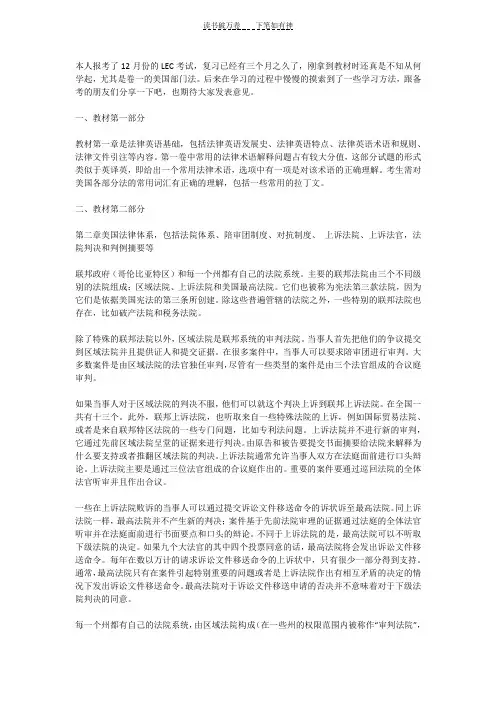
本人报考了12月份的LEC考试,复习已经有三个月之久了,刚拿到教材时还真是不知从何学起,尤其是卷一的美国部门法。
后来在学习的过程中慢慢的摸索到了一些学习方法,跟备考的朋友们分享一下吧,也期待大家发表意见。
一、教材第一部分教材第一章是法律英语基础,包括法律英语发展史、法律英语特点、法律英语术语和规则、法律文件引注等内容。
第一卷中常用的法律术语解释问题占有较大分值,这部分试题的形式类似于英译英,即给出一个常用法律术语,选项中有一项是对该术语的正确理解。
考生需对美国各部分法的常用词汇有正确的理解,包括一些常用的拉丁文。
二、教材第二部分第二章美国法律体系,包括法院体系、陪审团制度、对抗制度、上诉法院、上诉法官,法院判决和判例摘要等联邦政府(哥伦比亚特区)和每一个州都有自己的法院系统。
主要的联邦法院由三个不同级别的法院组成:区域法院、上诉法院和美国最高法院。
它们也被称为宪法第三款法院,因为它们是依据美国宪法的第三条所创建。
除这些普遍管辖的法院之外,一些特别的联邦法院也存在,比如破产法院和税务法院。
除了特殊的联邦法院以外,区域法院是联邦系统的审判法院。
当事人首先把他们的争议提交到区域法院并且提供证人和提交证据。
在很多案件中,当事人可以要求陪审团进行审判。
大多数案件是由区域法院的法官独任审判,尽管有一些类型的案件是由三个法官组成的合议庭审判。
如果当事人对于区域法院的判决不服,他们可以就这个判决上诉到联邦上诉法院。
在全国一共有十三个。
此外,联邦上诉法院,也听取来自一些特殊法院的上诉,例如国际贸易法院、或者是来自联邦特区法院的一些专门问题,比如专利法问题。
上诉法院并不进行新的审判,它通过先前区域法院呈堂的证据来进行判决。
由原告和被告要提交书面摘要给法院来解释为什么要支持或者推翻区域法院的判决。
上诉法院通常允许当事人双方在法庭面前进行口头辩论。
上诉法院主要是通过三位法官组成的合议庭作出的。
重要的案件要通过巡回法院的全体法官听审并且作出合议。
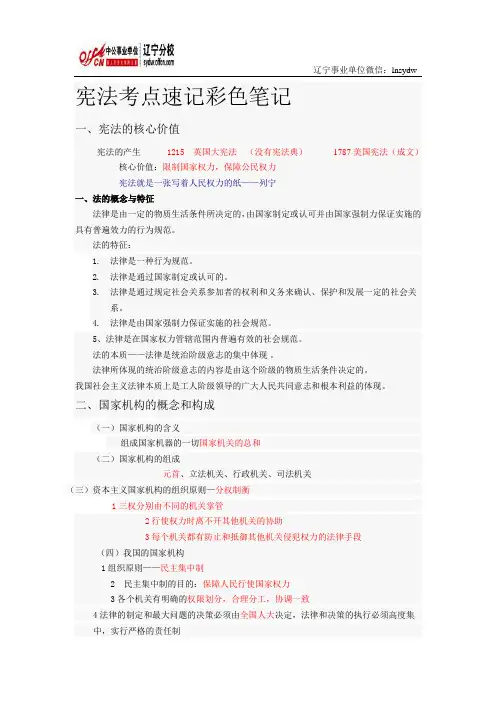
宪法考点速记彩色笔记一、宪法的核心价值宪法的产生1215 英国大宪法(没有宪法典)1787 美国宪法(成文)核心价值:限制国家权力,保障公民权力宪法就是一张写着人民权力的纸——列宁一、法的概念与特征法律是由一定的物质生活条件所决定的,由国家制定或认可并由国家强制力保证实施的具有普遍效力的行为规范。
法的特征:1. 法律是一种行为规范。
2. 法律是通过国家制定或认可的。
3. 法律是通过规定社会关系参加者的权利和义务来确认、保护和发展一定的社会关系。
4. 法律是由国家强制力保证实施的社会规范。
5、法律是在国家权力管辖范围内普遍有效的社会规范。
法的本质——法律是统治阶级意志的集中体现。
法律所体现的统治阶级意志的内容是由这个阶级的物质生活条件决定的。
我国社会主义法律本质上是工人阶级领导的广大人民共同意志和根本利益的体现。
二、国家机构的概念和构成(一)国家机构的含义组成国家机器的一切国家机关的总和(二)国家机构的组成元首、立法机关、行政机关、司法机关(三)资本主义国家机构的组织原则—分权制衡1三权分别由不同的机关掌管2行使权力时离不开其他机关的协助3每个机关都有防止和抵御其他机关侵犯权力的法律手段(四)我国的国家机构1组织原则——民主集中制2 民主集中制的目的:保障人民行使国家权力3各个机关有明确的权限划分,合理分工,协调一致4法律的制定和最大问题的决策必须由全国人大决定,法律和决策的执行必须高度集中,实行严格的责任制5遵循中央统一领导,地方发挥主动性、积极性的原则,划分中央和地方的等级职权(五)我国的国家构成国家主席、全国及地方人大及其常委会、国务院及地方政府、人民法院,人民检察院,中央军委权力制衡:1 人大和政府的权力划分(人大最高权力)2 人大和常委会的权力划分(人大每年召开一次会议、会期两周)三、全国人民代表大会(一)职权:立法权1/5以上的代表提议2/3的代表同意,没有宪法的制定权(可以修改宪法),基本法律的制定权任免权由国家主席提名决定总理重大事项的决定权国民经济,社会发展的计划,预算批准省、自治区、直辖市、特别行政区的建制战争与和平问题最高监督权(二)全国人大的工作程序提议案全国人大主席团、常委会,国务院,军委,二最,部门委员30个以上代表审议议案通过议案公布议案由国家主席签署公布或者全国人大主席团签署四、全国人大常委会1、全国人大的常设机关,服从人大的领导和监督2、常委会的组成:委员长,副委员长,秘书长,委员;应该有少数民族代表,二长的任期每届5年,最多2届3、职权:宪法解释和监督(不能修改)立法权和法律解释权(基本法律)1、重大事务的决定权(紧急)2、任免总理提名,决定部长,委员会主任,审计长,秘书长,各部部长人大代表权力(国务院官员)3、提议案30人提质问30个提出罢免权1/10 提出修改宪法1/54、言论免责权5、刑事豁免权开会期间全国人大主席团许可闭会期间全国人大常委会县级以上乡级得是最低的人大代表。
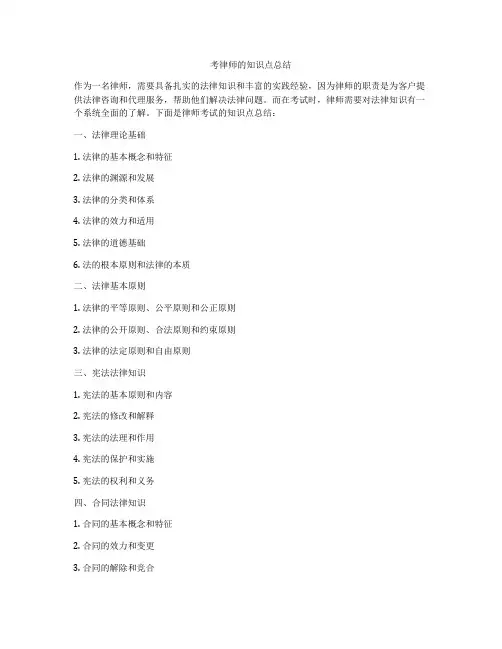
考律师的知识点总结作为一名律师,需要具备扎实的法律知识和丰富的实践经验,因为律师的职责是为客户提供法律咨询和代理服务,帮助他们解决法律问题。
而在考试时,律师需要对法律知识有一个系统全面的了解。
下面是律师考试的知识点总结:一、法律理论基础1. 法律的基本概念和特征2. 法律的渊源和发展3. 法律的分类和体系4. 法律的效力和适用5. 法律的道德基础6. 法的根本原则和法律的本质二、法律基本原则1. 法律的平等原则、公平原则和公正原则2. 法律的公开原则、合法原则和约束原则3. 法律的法定原则和自由原则三、宪法法律知识1. 宪法的基本原则和内容2. 宪法的修改和解释3. 宪法的法理和作用4. 宪法的保护和实施5. 宪法的权利和义务四、合同法律知识1. 合同的基本概念和特征2. 合同的效力和变更3. 合同的解除和竞合4. 合同的保护和违约5. 合同的修订和完善五、民事诉讼法律知识1. 民事诉讼的基本程序和要素2. 民事诉讼的受理和审理3. 民事诉讼的证据和调解4. 民事诉讼的判决和执行5. 民事诉讼的制度和改革六、刑法法律知识1. 刑事责任的基本原则和限制2. 刑事行为的构成和要件3. 刑事责任的形式和途径4. 刑事责任的变更和减免5. 刑事责任的特例和刑法学说七、行政法律知识1. 行政权力的性质和限制2. 行政行为的程序和要素3. 行政责任的追究和制约4. 行政监督的程序和手段5. 行政救济的途径和效果八、知识产权法律知识1. 知识产权的种类和范围2. 知识产权的取得和保护3. 知识产权的许可和转让4. 知识产权的侵权和救济5. 知识产权的实施和发展九、劳动法律知识1. 劳动合同的订立和变更2. 劳动报酬的支付和保障3. 劳动时间的安排和调整4. 劳动保障的制度和实施5. 劳动纠纷的解决和调解十、法律知识的应用1. 法律知识的运用和创新2. 法律知识的归纳和推演3. 法律知识的实践和改进4. 法律知识的思考和解析5. 法律知识的总结和应用在考试中,律师需要熟练掌握以上知识点,并能够在实际案例中灵活运用,加强对法律条文的理解和解释,对法律制度和体系的了解,对法律逻辑和推理的把握,在考试中可以较好地发挥。
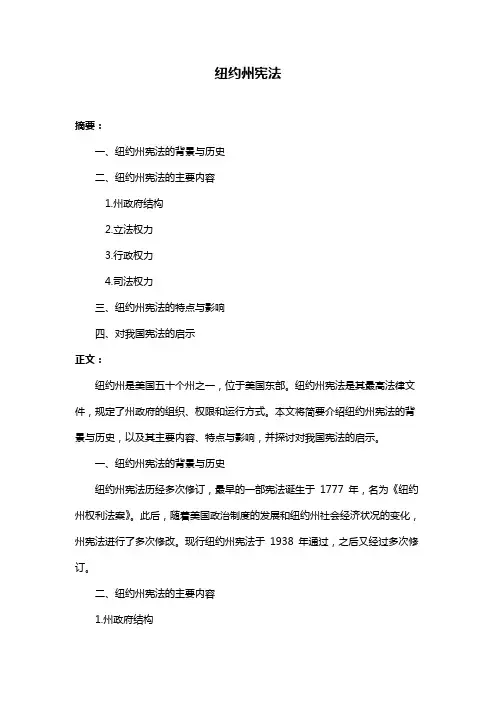
纽约州宪法摘要:一、纽约州宪法的背景与历史二、纽约州宪法的主要内容1.州政府结构2.立法权力3.行政权力4.司法权力三、纽约州宪法的特点与影响四、对我国宪法的启示正文:纽约州是美国五十个州之一,位于美国东部。
纽约州宪法是其最高法律文件,规定了州政府的组织、权限和运行方式。
本文将简要介绍纽约州宪法的背景与历史,以及其主要内容、特点与影响,并探讨对我国宪法的启示。
一、纽约州宪法的背景与历史纽约州宪法历经多次修订,最早的一部宪法诞生于1777 年,名为《纽约州权利法案》。
此后,随着美国政治制度的发展和纽约州社会经济状况的变化,州宪法进行了多次修改。
现行纽约州宪法于1938 年通过,之后又经过多次修订。
二、纽约州宪法的主要内容1.州政府结构纽约州宪法规定,州政府分为三个部门:立法、行政和司法。
立法部门包括一个两院制的议会,即参议院和众议院。
行政部门由州长领导,负责实施法律和监督政府各部门的工作。
司法部门包括最高法院和其他下级法院,负责审判和解决法律纠纷。
2.立法权力纽约州宪法赋予议会立法权,包括制定、修改和废止法律。
议会由参议院和众议院组成,参议院有63 名议员,众议院有150 名议员,均由选民选举产生。
3.行政权力纽约州长是州政府的最高行政长官,由选民选举产生,任期四年。
州长有权任命和辞退州政府各部门的官员,并有权否决议会通过的法律。
4.司法权力纽约州宪法规定,司法权独立于立法和行政权力。
州最高法院和其他下级法院负责审理各类案件,确保法律的公正执行。
三、纽约州宪法的特点与影响纽约州宪法的特点在于,它充分体现了分权制衡的原则。
通过设立三个相互独立的政府部门,确保各个权力部门之间相互制约、平衡,防止权力过于集中。
此外,纽约州宪法还规定了一系列公民权利,如言论、新闻、宗教和集会自由等。
纽约州宪法对我国宪法的启示在于,要充分体现民主、法治原则,强化权力制衡,保障公民权利。
同时,宪法应适应国家发展和人民需求的变化,不断进行修订和完善。
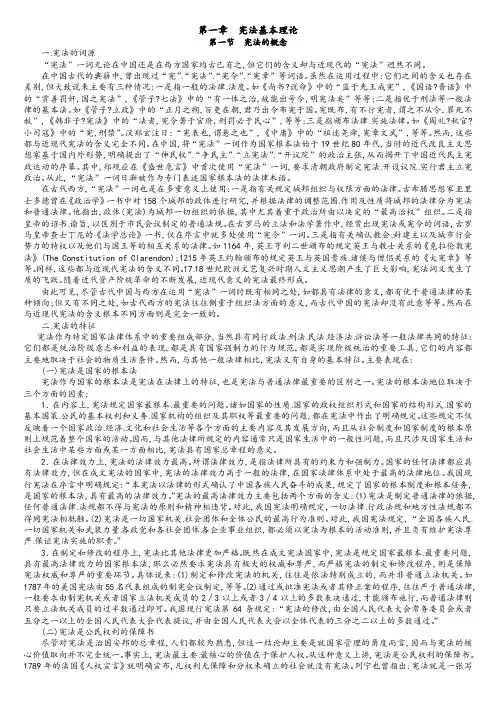
第一章宪法基本理论第一节宪法的概念一、宪法的词源“宪法”一词无论在中国还是在西方国家均古已有之,但它们的含义却与近现代的“宪法”迥然不同。
在中国古代的典籍中,曾出现过“宪”、“宪法”、“宪令”、“宪章”等词语。
虽然在运用过程中:它们之间的含义也存在差别,但大致说来主要有三种情况:一是指一般的法律、法度。
如《尚书?说命》中的“监于先王成宪”,《国语?晋语》中的“赏善罚奸,国之宪法”,《管子?七法》中的“有一体之治,故能出号令,明宪法矣”等等;二是指优于刑法等一般法律的基本法。
如《管子?立政》中的“正月之朔,百吏在朝,君乃出令布宪于国。
宪既布,有不行宪者,谓之不从令,罪死不赦”,《韩非子?宪法》中的“法者,宪令著于官府,刑罚必于民心”,等等;三是指颁布法律、实施法律。
如《周礼?秋官?小司寇》中的“宪,刑禁”。
汉郑玄注日:“宪表也,谓悬之也”,《中庸》中的“祖述尧舜,宪章文武”,等等。
然而,这些都与近现代宪法的含义完全不同。
在中国,将“宪法”一词作为国家根本法始于19世纪80年代,当时的近代改良主义思想家基于国内外形势,明确提出了“伸民权”、“争民主”、“立宪法”、“开议院”的政治主张,从而揭开了中国近代民主宪政运动的序幕。
其中,郑观应在《盛世危言》中首次使用“宪法”一词,要求清朝政府制定宪法、开设议院、实行君主立宪政治。
从此,“宪法”一词日渐被作为专门表述国家根本法的法律术语。
在古代西方,“宪法”一词也是在多重意义上使用:一是指有关规定城邦组织与权限方面的法律。
古希腊思想家亚里士多德曾在《政治学》一书中对158个城邦的政体进行研究,并根据法律的调整范围、作用及性质将城邦的法律分为宪法和普通法律。
他指出,政体(宪法)为城邦一切组织的依据,其中尤其着重于政治所由以决定的“最高治权”组织。
二是指皇帝的诏书、谕旨,以区别于市民会议制定的普通法规。
在古罗马的立法和法学著作中,经常出现宪法或宪令的词语,古罗马皇帝查士丁尼的《法学总论》一书,仅在序言中就多处使用“宪令”一词。
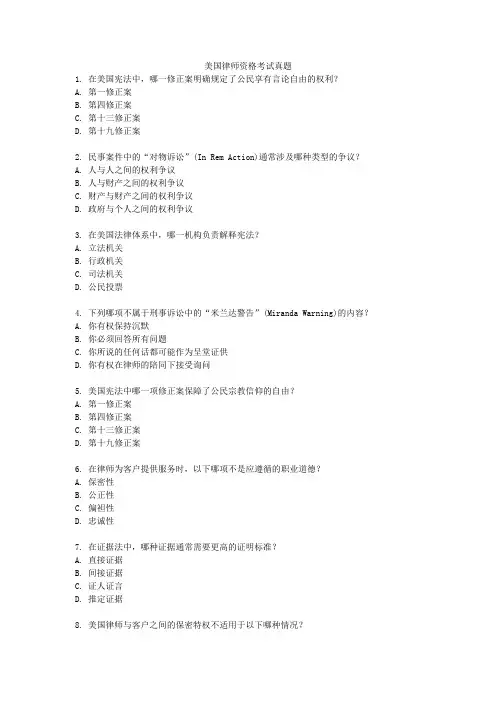
美国律师资格考试真题
1. 在美国宪法中,哪一修正案明确规定了公民享有言论自由的权利?
A. 第一修正案
B. 第四修正案
C. 第十三修正案
D. 第十九修正案
2. 民事案件中的“对物诉讼”(In Rem Action)通常涉及哪种类型的争议?
A. 人与人之间的权利争议
B. 人与财产之间的权利争议
C. 财产与财产之间的权利争议
D. 政府与个人之间的权利争议
3. 在美国法律体系中,哪一机构负责解释宪法?
A. 立法机关
B. 行政机关
C. 司法机关
D. 公民投票
4. 下列哪项不属于刑事诉讼中的“米兰达警告”(Miranda Warning)的内容?
A. 你有权保持沉默
B. 你必须回答所有问题
C. 你所说的任何话都可能作为呈堂证供
D. 你有权在律师的陪同下接受询问
5. 美国宪法中哪一项修正案保障了公民宗教信仰的自由?
A. 第一修正案
B. 第四修正案
C. 第十三修正案
D. 第十九修正案
6. 在律师为客户提供服务时,以下哪项不是应遵循的职业道德?
A. 保密性
B. 公正性
C. 偏袒性
D. 忠诚性
7. 在证据法中,哪种证据通常需要更高的证明标准?
A. 直接证据
B. 间接证据
C. 证人证言
D. 推定证据
8. 美国律师与客户之间的保密特权不适用于以下哪种情况?
A. 律师与客户之间的私人交流
B. 律师代表客户在法庭上的发言
C. 律师在社交场合偶然听到的客户私人信息
D. 律师代表客户与第三方进行的谈判。
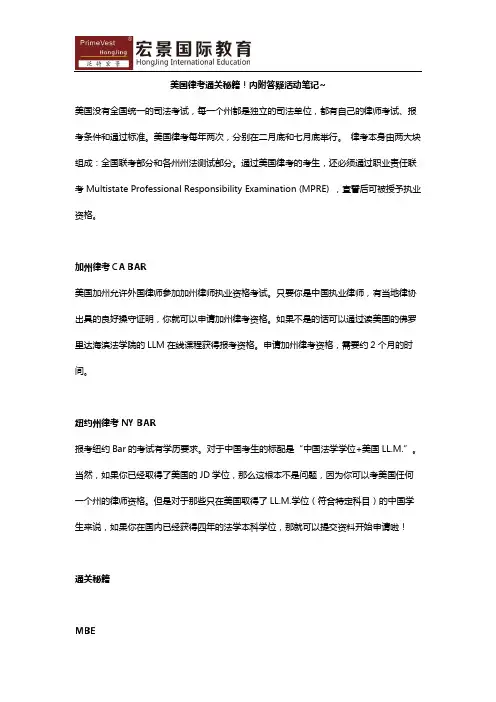
美国律考通关秘籍!内附答疑活动笔记~美国没有全国统一的司法考试,每一个州都是独立的司法单位,都有自己的律师考试、报考条件和通过标准。
美国律考每年两次,分别在二月底和七月底举行。
律考本身由两大块组成:全国联考部分和各州州法测试部分。
通过美国律考的考生,还必须通过职业责任联考Multistate Professional Responsibility Examination (MPRE) ,宣誓后可被授予执业资格。
加州律考CA BAR美国加州允许外国律师参加加州律师执业资格考试。
只要你是中国执业律师,有当地律协出具的良好操守证明,你就可以申请加州律考资格。
如果不是的话可以通过读美国的佛罗里达海滨法学院的LLM在线课程获得报考资格。
申请加州律考资格,需要约2个月的时间。
纽约州律考NY BAR报考纽约Bar的考试有学历要求。
对于中国考生的标配是“中国法学学位+美国LL.M.”。
当然,如果你已经取得了美国的JD学位,那么这根本不是问题,因为你可以考美国任何一个州的律师资格。
但是对于那些只在美国取得了LL.M.学位(符合特定科目)的中国学生来说,如果你在国内已经获得四年的法学本科学位,那就可以提交资料开始申请啦!通关秘籍MBE律考的全国联考部分是有专门机构统一命题MBE,考的是联邦统一法。
联考考核科目包括刑法、合同法、宪法、证据法、物权法、侵权法和民诉法。
MBE一共有两百道选择题,考生按每三个小时一百题的速度在两个时间段内完成,也就是说需要每1.8分钟就完成一道题目。
一道选择题的阅读量就是一个小案例,要将这个案例读懂消化,并且要知道考点在哪。
例如合同法,考生应该明白此合同有没有建立,如果已经建立,之后会有怎样的考点?如果有人来咨询合同,要了解是否有合同;还需要了解合同的形式,是书面的还是口头的;合同有没有违反书面要求的规定;然后看合同的权利和义务,看是否有违约;如果有违约,需要付出怎样的代价等。
200道选择题需要保证有65%以上的正确率才有通过保障。
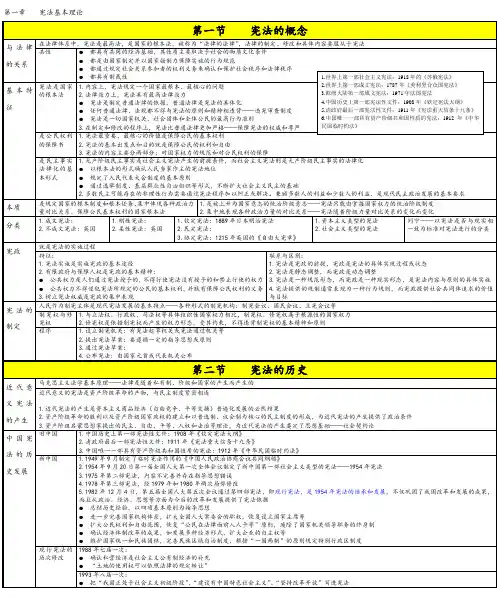
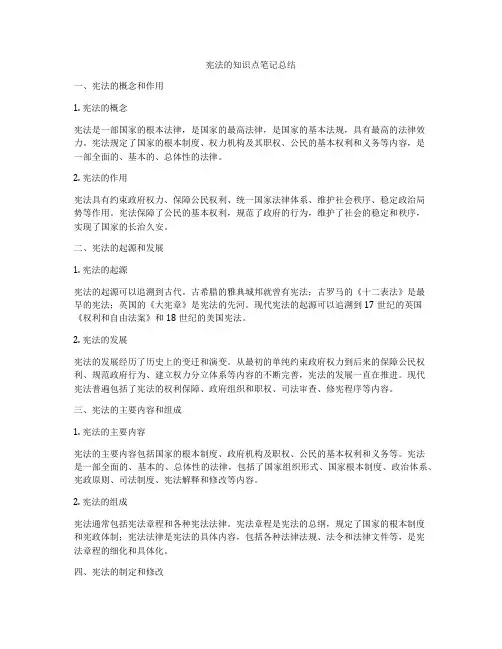
宪法的知识点笔记总结一、宪法的概念和作用1. 宪法的概念宪法是一部国家的根本法律,是国家的最高法律,是国家的基本法规,具有最高的法律效力。
宪法规定了国家的根本制度、权力机构及其职权、公民的基本权利和义务等内容,是一部全面的、基本的、总体性的法律。
2. 宪法的作用宪法具有约束政府权力、保障公民权利、统一国家法律体系、维护社会秩序、稳定政治局势等作用。
宪法保障了公民的基本权利,规范了政府的行为,维护了社会的稳定和秩序,实现了国家的长治久安。
二、宪法的起源和发展1. 宪法的起源宪法的起源可以追溯到古代。
古希腊的雅典城邦就曾有宪法;古罗马的《十二表法》是最早的宪法;英国的《大宪章》是宪法的先河。
现代宪法的起源可以追溯到17世纪的英国《权利和自由法案》和18世纪的美国宪法。
2. 宪法的发展宪法的发展经历了历史上的变迁和演变。
从最初的单纯约束政府权力到后来的保障公民权利、规范政府行为、建立权力分立体系等内容的不断完善,宪法的发展一直在推进。
现代宪法普遍包括了宪法的权利保障、政府组织和职权、司法审查、修宪程序等内容。
三、宪法的主要内容和组成1. 宪法的主要内容宪法的主要内容包括国家的根本制度、政府机构及职权、公民的基本权利和义务等。
宪法是一部全面的、基本的、总体性的法律,包括了国家组织形式、国家根本制度、政治体系、宪政原则、司法制度、宪法解释和修改等内容。
2. 宪法的组成宪法通常包括宪法章程和各种宪法法律。
宪法章程是宪法的总纲,规定了国家的根本制度和宪政体制;宪法法律是宪法的具体内容,包括各种法律法规、法令和法律文件等,是宪法章程的细化和具体化。
四、宪法的制定和修改1. 宪法的制定宪法的制定是国家的重大政治活动,通常需要经过立法机关或宪法制定机构的一系列程序。
宪法制定过程中必须充分尊重公民的意愿和利益,遵循宪政原则,进行广泛的社会听证和民意调查,最终由立法机关或宪法制定机构表决通过。
2. 宪法的修改宪法的修改是对宪法内容的修改和变更,通常需要经过立法机关或宪法修改机构的一系列程序。

纽约州宪法纽约州宪法是纽约州最高法律文件,确立了纽约州政府的结构和权限。
它由纽约州法律委员会负责撰写和修订,并由选民通过公民投票来修改。
第一部分:宣言和权利纽约州宪法的第一部分是宣言和权利。
它强调了个人的权利和政府的目标。
宣言中指出,“纽约州政府旨在建立正义、保护权利和提供福利”。
这部分还列举了几个基本权利,包括言论自由、宗教自由、新闻自由、和平集会自由以及私人产权保护。
第二部分:立法机构第二部分规定了纽约州的立法机构——参议院和议会。
它描述了选民如何选举参议员和议员,并规定了他们的任期和权力。
此外,宪法还规定了布法罗、罗切斯特、纽约市和其它一些大城市的特殊立法规定。
第三部分:行政部门第三部分规定了纽约州的行政部门,包括州长、副州长和州内阁的成员。
它描述了这些职位的职责和权力,并为州长行使权力的方法和原则制定了具体规定。
此外,宪法还规定了一些执行部门,如州务卿、财政部长和教育部长,并为每个部门制定了职责和权限。
第四部分:司法系统第四部分规定了纽约州的司法系统,包括各级法院和法官的职责和权限。
它列举了纽约州最高法院、上诉法院和各县法院的组成和权力,以及法官的选举和任期。
此外,宪法还规定了一些特殊法院,如家庭法院和刑事法院,并为它们制定了特殊规则和程序。
第五部分:公共财政第五部分规定了纽约州的公共财政政策,包括税收和预算制定。
它描述了如何征收税款,并规定了政府如何收入和支出。
此外,宪法还规定了州政府如何管理公共债务和资产,以及如何进行预算编制和审查。
第六部分:变更和修正宪法第六部分规定了纽约州宪法的修订程序。
它规定了如何修改宪法,包括法定多数和公民投票的要求。
此外,它还规定了宪法的修改如何提交给选民进行表决,并对修改后宪法的生效日期和执行方式进行了说明。
纽约州宪法是一部重要的法律文件,确保了公民的基本权利和政府的正当运作。
它为州政府的各个部分设立了明确的结构和权限,并规定了制定和修改法律的程序。
纽约州宪法是纽约州法律体系的基石,对于维护公民的权益和实现社会公正具有重要意义。
2015年司法考试《一卷》法制史考点:美国宪法
法制史是研究法律及相关制度的发生、发展、演变及其规律的科学。
狭义的法律史仅着重于法律本身的演进,而广义的法制史所包含的范围较广,除法律本身之、法律相关制度以及法律实行的情况外,还包括与社会之间的关系。
这里是由【店铺公务员司法考试网】为您整理提供的2015年司法考试《一卷》法制史考点:美国宪法,希望大家在了解考点的同时,运用到实际生活,考得好成绩!
(一)宪法的制定
1787年邦联国会邀请各州代表在费城召开秘密会议,修改《邦联条例》并越权起草了宪法。
该会议后来被称为制宪会议。
1789年,美国第一届联邦国会开幕,正式宣布联邦宪法生效。
(二)宪法的主要内容与修正案
1. 1787年《联邦宪法(Constitution of the United States of America)》的主要内容。
由序言和7条本文组成。
根据联邦法院解释,序言虽在宪法全文中,但不是宪法的组成部分,在审判活动中不能被引用。
宪法的主要内容包括:立法权、行政权、司法权、授予各州的权力、宪法修正案提出和通过的程序、强调宪法和根据宪法制定的法律以及缔结的条约是“全国最高法律”、宪法本身的批准问题。
2. 宪法修正案。
宪法修正案是美国宪法规定的惟一正式改变宪法的形式。
其中影响最大的是关于公民权利的宪法前10条修正案(即“权利法案”)、南北战争后关于废除奴隶制并承认黑人选举权的修正案、20世纪以降关于扩大选举权、男女享受平等权利的修正案。
I.Judicial Power 司法权–Article III (15% of questions)A.Requirement for Cases and Controversies –Justice Ability Doctrine对普通公民不能用军事法院审理(即便他是军队的EMPLYEE),除非民事法院被关了1.Standing– whether the plaintiff is the proper party to bring the matter to the court for adjudication自身因为第三人的原因受到伤害a.Injury: P must allege & prove that he has been injured or imminently will be injuredP only may assert injures that he personally suffered(i)P seeking injunctive or declaratory relief must show a likelihood of future harm– monetaryinterests are the strongest form of injuryTIP: If Q asks which has the best standing, look to a P who has personally suffered an injury. Thenchoose the one who has suffered an economic/monetary loss.b.Causation & Redressability– P must allege & prove that D caused the injury, so that a favorablecourt decision is likely to redress纠正 the injury (NO“advisory opinions”)c.NO 3rd party standing– P cannot assert claims of others (3rd parties) who are not before the courtEXCEPTIONS:(a)Close relationship between P & the injured 3rd party (e.g., abortion cases brought by doctorson behalf of their patients)这个是指金钱关系上的密切,不是人身关系(比如W和H)(b)Injured 3rd party is unlikely to be able to assert his own rights (e.g., criminal D’s can rai sethe rights of prospective juror in racial discrimination claim during jury selection)(c)“Associational” standing– an organization may sue for its members, provided-Members would have standing to sue-Interests are germane密切相关to the organization’s purpose-Neither the claim nor relief requires participation of individual membersd.NO generalized grievances –P must not be suing solely as a citizen or as a taxpayer interested inhaving the government follow the law (e.g. sued to disclose CIA budget – no standing b/c suingonly as a citizen)TIP: Exam will say “P is suing as a taxpayer”(i)EXCEPTION – taxpayers have standing to challenge government expenditures as violating theEstablishment Clause只能根据TAX & SPENDING 条款(ii)BUT, taxpayers lack standing to challenge government granting of property to religious institutions/ parochial schools2.Ripeness现实的争议问题//避免法院过早介入– can you get declaratory judgment that a law isunconstitutional? pre-enforcement review of a statute or regulation?注意:看法律是不是已经通过了~~Proposed//或者有过渡期(GRACE PERIOD)才执行的法律都属于未成熟的TIP: If Q talks about declaratory judgement, this is likely a ripeness issue.a.Hardship will be suffered without pre-enforcement review: the greater the hardship, the more likelythe court will allow declaratory judgmentb.Fitness of the issues & the record for judicial review– does the fed court have all it needs todecide the issue, or should it wait for more factual development? Is anything to be gained bywaiting for an actual prosecution?3.Mootness正在进行的而未消失的– must be an ongoing injury (if events after the filing of the lawsuitend P’s injury, it’s moot)EXCEPTIONS:(i)Wrong capable of repetition but evading review– e.g. an abortion case was decided after P hadher abortion because P could seek an abortion in the future (Roe v Wade)比如选举权等(ii)Voluntary cessation of offending practice, but D is legally free to resume it at any time(iii)Class action suits won’t be dismissed as long as 1 member of the class has an ongoing injury4.Political Question Doctrine– refers to allegations of constitutional violations that the federal courts(and level) will not adjudicate (matters left to political branch or inherently incapable of judicialresolution); e.g.:a.Cases under the “republican form of government clause”b.Challenges to the President’s conduct of foreign policyc.Challenges to the impeachment & removal processd.Challenges to partisan gerrymandering党派选区划分B.Supreme Court Review 最高法院的裁判权1.Appellate Jurisdiction议会可以对其作为上诉法院的审判权作出限制的,但不能全部取消但不能对其作为原审法院的审判权作出限制,当然也不能扩大~如果是审理州最高法院上诉而来的案子,必须是涉及到联邦法律问题的(解释联邦法律和直接适用联邦法律都算)!!(州法律和联邦法律内容是不是一样无所谓)如果联邦法院没法判断案子是不是涉及联邦问题,一般会DISMISS然后让州法院重审//如果确涉及到联邦问题,法院可以撤销,然后让州法院再根据州法律判。
88、93、99、04宪法修正案私营是补充,土地可转让。
(88)国营县市场,承包正协商。
(93)革命双为主,法治道路长。
(99)三乡建设者,财产有保障, (04)国事少戒严,经济全补偿。
四次修宪时间尾数谐音记忆:把散酒吃(8394)联想:修宪惠农,农民“把散酒吃”(农民穷,瓶装酒吃不起)故事情节串联:一个农民转让了土地,到县城承包国营市场,但经商仍不忘革命,致富后依靠宪法保障个人合法私有财产私营是补充土地可转让1私营经济是社会主义公有制经济的补充;国家对私营经济实行引导、监督和管理2土地使用权可以依法转让国营县市场承包正协商1国营:“国营经济”改为“国有经济”;“国营企业”改为“国有企业”,国有企业经营自主权;集体经济组织经营自主权2县:县级人大任期由3年改为5年3市场:国家的基本经济体制为社会主义市场经济4承包:农村中的家庭联产承包为主的责任制5正:我国正处于社会义初级阶段、建设有中国特色社会主义、坚持改革开放6协商:中国共产党领导的多党合作和政治协商制度将长期存在和发展革命双为主法治道路长1革命:“反革命”修改为“危害国家安全的犯罪”2双:农村集体经济组织实行家庭承包经营为基础、统分结合的双层经营体制3为主:公有制为主体、多种所有制经济共同发展;按劳分配为主、多种分配方式并存的分配制度。
个体经济、私营经济等非公有制经济,是社会主义市场经济的重要组成部分;国家对个体经济、私营经济实行引导、监督和管理4法治:实行依法治国,建设社会主义法治国家5道路长:我国将长期处于社会主义初级阶段、建设有中国特色社会主义的道路、在“邓小平理论指导下”、“发展社会主义市场经济”三乡建设者财产有保障国事少戒严经济全补偿1三:“三个代表”入宪2乡:乡镇人大任期由3年改为5年3建设者:爱国统一战线中增加“社会主义事业的建设者”4财产:公民的合法的私有财产不受侵犯(为公共利益可征收征用并补偿)5保障:国家建立健全同经济发展水平相适应的社会保障制度6国事:国家主席代表国家进行国事活动,接受外国时节7少:全国人大各代表团应有少数民族适当名额代表8戒严:“戒严”改为“紧急状态”9经济:国家保护个体经济、私营经济等非公有制经济的合法的权利和利益。
纽约州宪法
摘要:
1.纽约州宪法的概述
2.纽约州宪法的历史
3.纽约州宪法的主要内容
4.纽约州宪法的修订
5.纽约州宪法对纽约州的影响
正文:
纽约州宪法是美国纽约州的根本法,它于1777 年4 月20 日通过,并在此后经历了多次修订。
纽约州宪法是纽约州最高的法律,它规定了纽约州的政治制度、权利和自由、以及政府的组织和职能。
纽约州宪法的历史可以追溯到美国独立战争时期。
在1777 年,纽约州的代表们在康乃尔大学的会议上起草了纽约州宪法。
这个宪法在1777 年4 月20 日通过,并在1780 年生效。
此后,纽约州宪法经历了多次修订,以适应社会和政治的变化。
纽约州宪法的主要内容包括:确立了纽约州政府的组织和职能,规定了纽约州的选举制度,保障了纽约州居民的基本权利和自由,如言论自由、宗教自由、财产权等。
此外,纽约州宪法还规定了纽约州的司法制度,包括法院的组织和职能。
纽约州宪法的修订是一个重要的过程,需要通过纽约州立法机关和纽约州选民的投票来完成。
修订的目的是为了适应社会和政治的变化,使宪法更加符
合时代发展的需要。
纽约州宪法对纽约州的影响深远。
它为纽约州建立了一个稳定和有效的政治制度,保障了纽约州居民的基本权利和自由,为纽约州的发展提供了坚实的法律基础。
司法考试一卷备考笔记:宪法的含义店铺司法考试考试栏目整理“司法考试一卷备考笔记:宪法的含义”希望可以帮到广大考生,更多信息,请继续关注我们网站的更新!一、宪法的词源:中国在中国古代的典籍中,曾出现过“宪”、“宪法”、“宪令”、“宪章”等词语。
它们的含义主要有三种情况:一是指一般的法律、法度。
二是指优于刑法等一般法律的基本法律。
三是指颁布法律、实施法律。
在中国,将“宪法”一词作为国家根本法始于19世纪80年代,邓观应在《盛世危言》中,首次使用了宪法一词。
西方在古代西方,“宪法”一词也是在多重意义上使用:古希腊:一是指有关规定城邦组织与权限方面的法律。
古罗马:二是指皇帝的诏书、谕旨,以区别于市民会议制定的普通法规。
英国:三是指有关确认教会、封建主以及城市行会势力的特权,以及他们与国王等的相互关系的法律。
宪法词义发生质的变化,始于17、18世纪欧洲文艺复兴时期。
近代资产阶级革命的成功,近现代意义的宪法才最终形成。
近代共同特征:1、都是代表统治阶级的意志2、都是国家制定或者认可的,具有国家强制力的行为规范3、都是通过对社会关系参与者的权利义务的确认、保护和发展来形成对统治阶级有利的社会关系和社会秩序,是统治阶级治理国家的重要工具。
4、宪法规范的内容取决于相应社会的物质条件。
二、宪法的特征:(一)宪法是国家的根本法:1、在内容上,宪法规定国家最根本、最重要的问题:我国规定了根本任务和根本制度。
2、在法律效力上,宪法的法律效力最高:① 宪法是普通法律的立法依据或立法基础。
这并不是最高法律效力的体现② 普通法律与宪法不相抵触的原则。
③ 宪法是全国各族人民、一切国家机关和武装力量、各政党和各社会团体、各企业事业组织和全体公民的最高行为准则。
都必须以宪法为根本的活动准则。
3、在制定和修改的程序上,宪法比其他法律更加严格由于宪法所规定的内容是一个国家最根本的制度、原则,是其它法律赖以建立的依据,为了保证宪法的尊严和相对稳定性,绝大多数国家在制宪和修宪程序上作了严格的要求。
2023年律师招聘考试公共基础知识重点
复习笔记(精选)
1. 宪法法律知识
- 宪法的基本原则
- 公民的基本权利和义务
- 国家机构的组织和职权
- 全国人民代表大会和地方各级人民代表大会的职权
2. 刑法基础知识
- 刑法的基本原则
- 犯罪构成与犯罪责任
- 刑法责任的种类和限制
- 刑法的适用和解释
3. 民法基础知识
- 民法的基本原则
- 民事主体和民事行为
- 民事权利和义务
- 民事责任和法律保护
4. 行政法基础知识
- 行政法的基本原则
- 行政行为和行政行为的效力- 行政权力和行政裁量权
- 行政复议和行政诉讼
5. 经济法基础知识
- 经济法的基本原则
- 市场经济的基本制度
- 经济合同和信用制度
- 经济犯罪和经济法律责任
6. 劳动法基础知识
- 劳动法的基本原则
- 劳动合同和劳动报酬
- 劳动争议解决和劳动保护- 劳动纠纷处理和劳动监察
这份文档旨在提供2023年律师招聘考试公共基础知识的重点复习记录。
以上只是一些内容的概要,并不包括所有方面,考生仍需在相关教材和法律法规中进行深入学习和复习。
I.Judicial Power 司法权–Article III (15% of questions)A.Requirement for Cases and Controversies –Justice Ability Doctrine对普通公民不能用军事法院审理(即便他是军队的EMPLYEE),除非民事法院被关了1.Standing– whether the plaintiff is the proper party to bring the matter to the court for adjudication自身因为第三人的原因受到伤害a.Injury: P must allege & prove that he has been injured or imminently will be injuredP only may assert injures that he personally suffered(i)P seeking injunctive or declaratory relief must show a likelihood of future harm– monetaryinterests are the strongest form of injuryTIP: If Q asks which has the best standing, look to a P who has personally suffered an injury. Thenchoose the one who has suffered an economic/monetary loss.b.Causation & Redressability– P must allege & prove that D caused the injury, so that a favorablecourt decision is likely to redress纠正 the injury (NO“advisory opinions”)c.NO 3rd party standing– P cannot assert claims of others (3rd parties) who are not before the courtEXCEPTIONS:(a)Close relationship between P & the injured 3rd party (e.g., abortion cases brought by doctorson behalf of their patients)这个是指金钱关系上的密切,不是人身关系(比如W和H)(b)Injured 3rd party is unlikely to be able to assert his own rights (e.g., criminal D’s can rai sethe rights of prospective juror in racial discrimination claim during jury selection)(c)“Associational” standing– an organization may sue for its members, provided-Members would have standing to sue-Interests are germane密切相关to the organization’s purpose-Neither the claim nor relief requires participation of individual membersd.NO generalized grievances –P must not be suing solely as a citizen or as a taxpayer interested inhaving the government follow the law (e.g. sued to disclose CIA budget – no standing b/c suingonly as a citizen)TIP: Exam will say “P is suing as a taxpayer”(i)EXCEPTION – taxpayers have standing to challenge government expenditures as violating theEstablishment Clause只能根据TAX & SPENDING 条款(ii)BUT, taxpayers lack standing to challenge government granting of property to religious institutions/ parochial schools2.Ripeness现实的争议问题//避免法院过早介入– can you get declaratory judgment that a law isunconstitutional? pre-enforcement review of a statute or regulation?注意:看法律是不是已经通过了~~Proposed//或者有过渡期(GRACE PERIOD)才执行的法律都属于未成熟的TIP: If Q talks about declaratory judgement, this is likely a ripeness issue.a.Hardship will be suffered without pre-enforcement review: the greater the hardship, the more likelythe court will allow declaratory judgmentb.Fitness of the issues & the record for judicial review– does the fed court have all it needs todecide the issue, or should it wait for more factual development? Is anything to be gained bywaiting for an actual prosecution?3.Mootness正在进行的而未消失的– must be an ongoing injury (if events after the filing of the lawsuitend P’s injury, it’s moot)EXCEPTIONS:(i)Wrong capable of repetition but evading review– e.g. an abortion case was decided after P hadher abortion because P could seek an abortion in the future (Roe v Wade)比如选举权等(ii)Voluntary cessation of offending practice, but D is legally free to resume it at any time(iii)Class action suits won’t be dismissed as long as 1 member of the class has an ongoing injury4.Political Question Doctrine– refers to allegations of constitutional violations that the federal courts(and level) will not adjudicate (matters left to political branch or inherently incapable of judicialresolution); e.g.:a.Cases under the “republican form of government clause”b.Challenges to the President’s conduct of foreign policyc.Challenges to the impeachment & removal processd.Challenges to partisan gerrymandering党派选区划分B.Supreme Court Review 最高法院的裁判权1.Appellate Jurisdiction议会可以对其作为上诉法院的审判权作出限制的,但不能全部取消但不能对其作为原审法院的审判权作出限制,当然也不能扩大~如果是审理州最高法院上诉而来的案子,必须是涉及到联邦法律问题的(解释联邦法律和直接适用联邦法律都算)!!(州法律和联邦法律内容是不是一样无所谓)如果联邦法院没法判断案子是不是涉及联邦问题,一般会DISMISS然后让州法院重审//如果确涉及到联邦问题,法院可以撤销,然后让州法院再根据州法律判。
a.Writ of Certiorari – all cases from (i) highest state courts, & (ii) U.S. federal court of appeals. 4justices must agree to grant Certiorari in order for the case to be heard (completely discretionary)b.Appeal – for decisions of 3-judge federal district courts (appeals skip the U.S. federal court ofappeals). Supreme Court is obligated to take the case. The scope of appellate is subject to limitationof congress, though congress cannot take away as a whole.2.Original Jurisdiction – suits between states & cases involving ambassadors//public minister//conselur3.Exclusive jurisdiction – suits between states//involving a state4.Final Judgment Rule - NO interlocutory review by Supreme Court – may hear cases only after there hasbeen a final judgment.5.For Supreme Court to review a state court decision, there must NOT be an independent & adequatestate law ground of decision– Supreme Court will not hear a case only if the independent state ground is adequate by itself to support the decisionTIP: Rodney King sues in state court – state law battery claim and federal law civil rights claim and eachclaim will result in the same amount of damages. P wins. D sues all the way up to Supreme Court. No good, because same judgment would occur from the state law ground even if the federal ground was overturned.C.Lower Federal Court Review 低级联邦法院的审判权---对州的审判权1.Federal courts may not hear suits against state governments (11th Amendment)是指公民或外国政府起诉州~~!联邦和其他州是可以起诉州的2.Sovereign immunity bars suits against states in state courts or federal agencies.– EXCEPTa.Waiver is permitted (i.e., the state consents)b.States may be sued pursuant to federal laws adopted under §5 of the 14th Amendment– Congressmay adopt laws “to enforce” the 14th Amendment, limiting state sovereignty (like Title VII (1964Civil Rights Act) cases)c.Federal government may sue state governments–sovereign immunity doesn’t bar thisd.Suits against state officers are allowed;可以起诉官员的,但国库不能赔付过去的损害;可以起诉要求未来的利益。